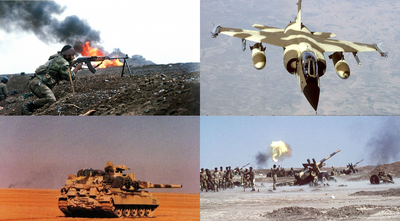1986 Cyrenian-Kermani War
| 1986 Cyrenian-Kermani War | |||||||
|---|---|---|---|---|---|---|---|
 Clockwise from the top left: Fighter of the Islamic Mobilisation Army during fighting outside Borazjan, Armed CyAF Mirage F1 fighter above Lilaea, Kermani Royal Army artillery battery firing during the November counter-offensive, Kentavros 1M3 tanks of the XI Armoured Division during the battle of Dorud | |||||||
| |||||||
| Belligerents | |||||||
|
Supported by: |
Supported by: | ||||||
| Commanders and leaders | |||||||
|
|
| ||||||
| Strength | |||||||
|
20,000 irregulars |
50,000 irregulars | ||||||
| Casualties and losses | |||||||
|
|
| ||||||
The 1986 Cyrenian-Kermani War also known as the Fourth Cyrenian-Kermani War and in certain Cyrenian cycles as the War of Shame, was a military conflict between the Cyrenian Republic and the Kingdom of Kerman. The war was preceded by constant skirmishing between Cyrenian and Kermani troops as well as militias from both sides along the line of contact on the borders of the Nisos Special Region, a Cyrenian enclave established in Cyrenian-majority region of Nisos after the 1981 war. The war started with Operation Nike, launched by the Cyrenian Armed Forces on September 12, 1986, and saw significant Cyrenian success due to the disorganised nature of the Kermani military. Cyrenian forces advanced deep into Kerman, reaching as far as the city of Dorud and laying siege to it. However, the Cyrenian troops found themselves overstretched, with their supply lines long and valnurable to attacks by Kermani irregulars. Overwhelmed by the fully mobilised Kermani military and its major counter-offensives, Cyrenian forces were forced to retreat all the way back to the NSR in November, where they also lost half of the city of Lilaea (Nehavand in Kermani) to the Kermanis. The war ended on 7 October 1986 with a ceasfire signed at the [TBD] Accords.
The conflict has been characterised as a war of Cyrenian overconfidence due to their successes against Kerman in previous wars, especially the daring and massively successful amphibious invasion to take Nisos in 1981. Known as the War of Shame by more left-leaning and progressive groups in Cyrenia, it is thought of as a war of unfettered aggression, in contrast to the perceived necessity of the eariler wars. The disaster of the offensive and the massive casualties taken by Cyrenia caused the collapse of the centre-right Anastasopoulos government and the election of the left-wing Socialist Party. In Kerman, the success in the defence of the Kermani mainland reinvigorated the morale of the population, and Sirvan II's popularity rose significantly. There were, however, more militant critics within the country that claimed that signing the ceasefire and not moving in to recapture Nisos when in a position of relative strength, was at best a wasted opportunity and at worst treason.
The war and in particular the division of the city of Lilaea in Cyrenian and Kermani-occupied zones served as a stepping stone for increased ethnic volience. The main two militia groups to arise were the Antqam (literally "revenge") Battalions, an offshoot of the state-sponsired Kermani Islamic Mobilisation Army, and the Cyrenian Nisos Defence Front, a militia originally created by the Cyrenian invasion forces in the 1981 war that gradually became more and more independent. The Green Line, as the border within the Lilea came to be known, became the scene of constant rioting and open skirmishes between these militias, while Cyrenian and Kermani troops remained mostly passive. The neighbouring Cyrenian city of Dimale, situated near the line of contact and hosting a significant Kermani minority (roughtly 40% of the population) also became a battlefield between the two groups, with local police and limited military forces unable to contain the violence. This prompted the launch of Operation Kronos, a Cyrenian military operation to quell violence in cities along the line of contact and restore order.